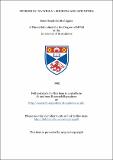Files in this item
Petronius' 'Satyrica' : sources and affinities
Item metadata
| dc.contributor.author | Rodriguez, Kate Hendricks | |
| dc.coverage.spatial | 88 p. | en_US |
| dc.date.accessioned | 2018-07-17T16:04:16Z | |
| dc.date.available | 2018-07-17T16:04:16Z | |
| dc.date.issued | 1995 | |
| dc.identifier.uri | https://hdl.handle.net/10023/15508 | |
| dc.description.abstract | In the ongoing debate over the genre of the Satyricon of Petronius, the theories that the work is a parody of the Greek romance or that it is a mock-epic have reached a level of orthodoxy. The Satyricon's stylistic and thematic affinities to satire, mime. New Comedy and the comic romance have supported a lively debate in the academic community also. However, the rhetorical basis of Petronius has been largely overlooked. In this thesis, I challenge the orthodox arguments of Greek romance and mock-epic, and I propose alternative literary sources for consideration, in particular that of Roman declamation. In Chapter I, I look at the structure of the epic: the function of the ira Priapi in relation to Homer's Poseidon and the occasion-problem-resolution structural pattern of epic with regard to the Satyricon's form. This yields interesting questions about the validity of the mock-epic argument. Similarly, in Chapter II, I challenge the Greek romance parody hypothesis on several levels. A brief look through the chronology of the Greek romance shows its height of popularity a full century or more after Petronius. A study of Giton and Encolpius, the central couple of the Satyricon, demonstrates significant differences in their characterization from any personae of Greek romance. Additionally, the entire cast of Petronius assumes a different position in society than does the cast of Greek romance. Further into Chapter II, I debate the more recent assertions that the Satyricon is indebted (via Greek romance) to Near Eastern and Egyptian literature. Lastly, I discuss as influential on Petronius, several other genres of narrative fiction: [Greek characters], and the comic romance. In Chapter III, I put forward as an argument Petronius' debt to Roman declamation, which has been heretofore virtually ignored. In the first half of the chapter, I discuss counterparts in theme and style between the scenes of the Satyricon and Roman declamation cases. In the latter half of the chapter, I examine the cast of Petronius as a whole, finding counterparts in declamation literature and other genres with which the Satyricon has affinities. This study of character seems to show that a majority of the cast comes from the world of declamation. | en_US |
| dc.language.iso | en | en_US |
| dc.subject.lcc | PA6559.R7 | en |
| dc.subject.lcsh | Petronius Arbiter. Satyricon | en |
| dc.title | Petronius' 'Satyrica' : sources and affinities | en_US |
| dc.type | Thesis | en_US |
| dc.type.qualificationlevel | Masters | en_US |
| dc.type.qualificationname | MPhil Master of Philosophy | en_US |
| dc.publisher.institution | The University of St Andrews | en_US |
This item appears in the following Collection(s)
Items in the St Andrews Research Repository are protected by copyright, with all rights reserved, unless otherwise indicated.

